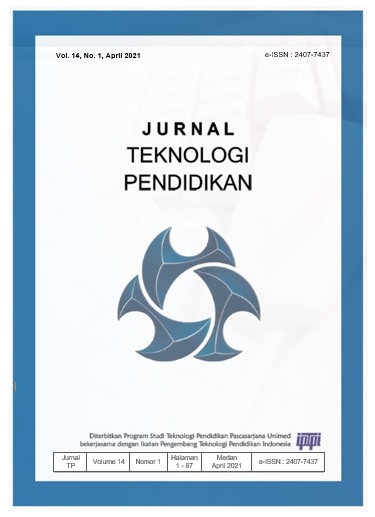PENGEMBANGAN MODUL PRAKTIKUM TEMA ALAT PENGENDALI PENCEMAR UDARA BERBASIS AUGMENTED REALITY
DOI:
https://doi.org/10.24114/jtp.v14i1.22203Keywords:
air pollutant controller, development, KU-AR application, practicum moduleAbstract
Abstrak: Penciptaan dan pengembangan material pembelajaran dalam situasi ketidakpastian saat ini merupakan tantangan yang dihadapi pendidik. Tantangan tersebut terjawab seiring teknologi Augmented dan Virtual Reality (AR dan VR) mulai diterapkan di kelas praktikum. Pengembangan modul praktikum mata kuliah Kualitas Udara dan penilaian keberterimaan modul bagi mahasiswa Prodi D3 Teknik dan Manajemen Lingkungan merupakan tujuan dalam penelitian ini. Modul terdiri dari buku panduan, marker AR, aplikasi KU-AR dan kuisioner formatif yang diisi oleh responden 28 mahasiswa. Analisis formatif menunjukkan mayoritas mahasiswa dapat menerima modul dan menjadi termotivasi untuk mempelajari desain alat pengendali pencemar udara lanjutan. Pengenalan alat pengendali pencemar udara melalui modul AR dapat memberikan pengalaman yang berguna bagi mahasiswa, khususnya vokasi. Kata Kunci: alat pengendali, aplikasi KU-AR, modul praktikum, pengembanganAbstract: The creation and development of learning materials in today's uncertainty is a challenge for educators. Augmented and Virtual Reality (AR and VR) technologies responded to this challenge since they began to be applied in practicum classes. The development of the practicum module for the Air Quality course and the assessment of module acceptance for D3 Engineering and Environmental Management Study Program students are the objectives of this research. The module consists of a guidebook, AR markers, the KU-AR application, and a formative questionnaire filled out by 28 student respondents. The constructive analysis shows that most students can receive the module and become motivated to study advanced air pollutant control design. The introduction of air pollutant controllers through the AR module can provide a useful experience for students, especially vocational students.Keywords: air pollutant controller, development, KU-AR application, practicum moduleReferences
Ambarwulan, D., & Muliyati, D. (2016). The Design of Augmented Reality Application as Learning Media Marker-Based for Android Smartphone. Jurnal Penelitian & Pengembangan Pendidikan Fisika P-ISSN: 2461-0933 e-ISSN:2461-1433, 2(1), 73“80.
Bakri, F., Oktaviani Marsal, & Muliyati, D. (2019). Textbooks Equipped with Augmented Reality Technology for Physics Topic in High-School. Jurnal Penelitian & Pengembangan Pendidikan Fisika, 5(2), 113“122. https://doi.org/10.21009/1.05206
Bakri, F., Permana, H., Wulandari, S., & Muliyati, D. (2020). Student worksheet with ar videos: Physics learning media in laboratory for senior high school students. Journal of Technology and Science Education, 10(2), 231“240. https://doi.org/10.3926/JOTSE.891
Bazarov, S. E., Kholodilin, I. Y., Nesterov, A. S., & Sokhina, A. V. (2017). Applying Augmented Reality in practical classes for engineering students. IOP Conference Series: Earth and Environmental Science, 87(3). https://doi.org/10.1088/1755-1315/87/3/032004
Cabero Almenara, J., & Barroso Osuna, J. (2016). Posibilidades educativas de la Realidad Aumentada. Journal of New Approaches in Educational Research, 6(1), 44“50. https://doi.org/10.7821/naer.2016.1.140
Chen, Y. C. (2019). Effect of Mobile Augmented Reality on Learning Performance, Motivation, and Math Anxiety in a Math Course. Journal of Educational Computing Research, 57(7), 1695“1722. https://doi.org/10.1177/0735633119854036
Costa, M. C., Patricio, J. M., Carranca, J. A., & Farropo, B. (2018). Augmented reality technologies to promote STEM learning. Iberian Conference on Information Systems and Technologies, CISTI, 2018-June(June), 1“4. https://doi.org/10.23919/CISTI.2018.8399267
Di Serio, Ã., Ibáñez, M. B., & Kloos, C. D. (2013). Impact of an augmented reality system on students™ motivation for a visual art course. Computers and Education, 68, 586“596. https://doi.org/10.1016/j.compedu.2012.03.002
Guo, W. (2018). Improving engineering education using augmented reality environment. In Lecture Notes in Computer Science (including subseries Lecture Notes in Artificial Intelligence and Lecture Notes in Bioinformatics): Vol. 10924 LNCS. Springer International Publishing. https://doi.org/10.1007/978-3-319-91743-6_18
Kamarainen, A., Reilly, J., Metcalf, S., Grotzer, T., & Dede, C. (2018). Using Mobile Location-Based Augmented Reality to Support Outdoor Learning in Undergraduate Ecology and Environmental Science Courses. The Bulletin of the Ecological Society of America, 99(2), 259“276. https://doi.org/10.1002/bes2.1396
Khan, T., Johnston, K., & Ophoff, J. (2019). The Impact of an Augmented Reality Application on Learning Motivation of Students. Advances in Human-Computer Interaction, 2019. https://doi.org/10.1155/2019/7208494
Kusumaningrum, A., Ayuningtyas, A., Lopes, J. B., Engineering, I., Program, S., & Yogyakarta, L. A. (2019). Utilization of augmented reality technology in 3d visualization of high school of adisutjipto technology based on android. 1(2).
Mathews, N. S., Chimalakonda, S., & Jain, S. (2020). AiR - An Augmented Reality Application for Visualizing Air Pollution. ArXiv, 1“18.
Morrison, G. R., Ross, S. M., & Kalman, H. K. (2012). Designing Effective Instruction, 7th Edition. John Wiley & Sons, Incorporated. https://books.google.co.id/books?id=HSwcAAAAQBAJ
Nur, F., & Masykuri, M. (2019). JPBI ( Jurnal Pendidikan Biologi Indonesia ) Augmented Reality for teaching science : Students ™ problem solving skill , motivation , and learning outcomes. 5(2), 305“312.
Patricia Aguilera-Hermida, A. (2020). College students™ use and acceptance of emergency online learning due to COVID-19. International Journal of Educational Research Open, 1(July), 100011. https://doi.org/10.1016/j.ijedro.2020.100011
Sumarna, K. (2019). Pengaplikasian Augmented Reality Pada Modul Pembelajaran Menggambar Teknik 2 dan CAD di Program Studi Pendidikan Teknik Bangunan, Fakultas Teknik, Universitas Negeri Jakarta. Jurnal PenSil, 8(2), 89“96. https://doi.org/10.21009/jpensil.v8i2.11956
Theodorou, P., & Botzori, M. (2018). Augmented Reality Proves To Be a Breakthrough. July. https://doi.org/10.13140/RG.2.2.24330.98241
Veas, E., Grasset, R., Ferencik, I., Grünewald, T., & Schmalstieg, D. (2013). Mobile augmented reality for environmental monitoring. Personal and Ubiquitous Computing, 17(7), 1515“1531. https://doi.org/10.1007/s00779-012-0597-z
Wang, Lawrence K; Pereira, Norman C; Hung, Y.-T. (2004). Air Pollution Control Engineering. In Air Pollution Control Engineering (Volume 1). Humana Press, Inc. https://doi.org/10.1007/978-1-59259-778-9
Downloads
Published
How to Cite
Issue
Section
License
Copyright (c) 2021 Jurnal Teknologi Pendidikan (JTP)

This work is licensed under a Creative Commons Attribution 4.0 International License.

Jurnal Teknologi Pendidikan (JTP) is licensed under a Lisensi Creative Commons Atribusi 4.0 Internasional.




